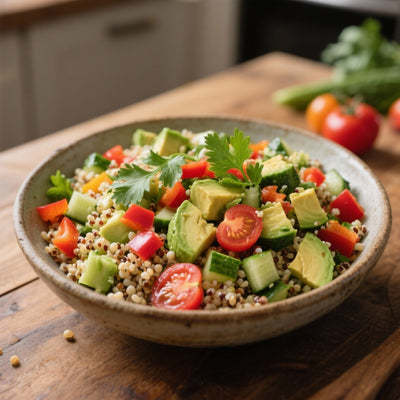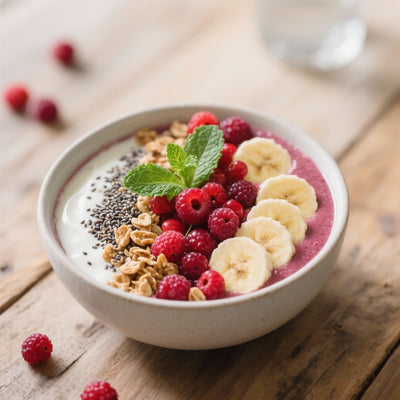What is exercise adaptation and how does Shilajit accelerate it?
You give it your all at the gym, week after week. You follow your program, you push your limits, but progress seems to slow down, or even stagnate. This frustration, this feeling of hitting an invisible wall, is an experience shared by many athletes, both amateur and professional. The secret to breaking through this plateau doesn't always lie in more intense training, but in better adaptation to exercise . It's your body's ability to rebuild itself stronger after each session. What if an ancient secret of nature could amplify this ability tenfold? In this article, we'll explore the science of adaptation and reveal how Shilajit, a natural substance from the Himalayan mountains, can become your most powerful ally in accelerating your recovery, strength, and endurance.
Understanding Adaptation to Exercise: The Science of Progression
Adaptation to exercise is the fundamental physiological process that allows us to become stronger, faster, and more enduring. It's our body's response to the stress we place upon it. Without adaptation, there is no progress. To truly optimize our results, we must first understand its mechanisms.
The Principle of Progressive Overload
At the heart of all progress lies the principle of progressive overload . For your body to adapt, you must constantly subject it to slightly more stress than it's used to. Whether it's adding weight to the bar, running a little faster, or doing one more repetition, this overload is the signal that triggers the cascade of adaptations. The body, in its quest for homeostasis, tells itself: "That effort was difficult. I need to get stronger so that next time, it will be easier." It's this simple biological dialogue that leads to extraordinary transformations.
Key Mechanisms of Adaptation
Adaptation is not a vague concept; it is a set of tangible changes that occur at several levels of your body:
- Muscle Adaptation: The micro-tears created in the muscle fibers during exertion are repaired and overcompensated, leading to hypertrophy (muscle growth) and an increase in strength.
- Neurological Adaptation: Your nervous system becomes more efficient at recruiting muscle fibers. This is why, in the first few weeks of a new program, you gain strength even before you see visible muscle growth.
- Cellular Adaptation: At the microscopic level, your cells increase their production of mitochondria, the "energy factories." More mitochondria means more available energy (ATP), and therefore better endurance.
- Cardiovascular Adaptation: Your heart becomes stronger, able to pump more blood with each beat, and your body develops a denser capillary network to better oxygenate the muscles.
The Crucial Role of Recovery
It's an often overlooked truth: you don't progress during training, but during recovery. Training is the stimulus; recovery is the phase where adaptation occurs. Quality sleep, proper nutrition, and stress management are the cornerstones of this phase. Ignoring recovery is like planting seeds without ever watering them: the potential for growth is there, but it will never be realized.
"The biggest obstacle to performance is not the failure of training, but the failure of recovery. The body adapts to the stress it can handle, not to that which is imposed on it indiscriminately."
What is Shilajit? A Treasure of the Mountains
Amidst the rugged peaks of the Himalayas, an ancient substance seeps from the rocks under the sun's heat. Known for millennia in Ayurvedic medicine as the "destroyer of weakness," Shilajit is a mineral-rich resin formed by the slow decomposition of plant matter over centuries. It is not a herb, but a mineral biomass of exceptional nutritional density.
Unique Origin and Composition
Shilajit is a concentrate of over 85 minerals and trace elements in their ionic form, the most bioavailable to the human body. But its most valuable component is fulvic acid.
Fulvic Acid: The Energy Carrier
Imagine fulvic acid as a smart delivery system at the cellular level. Its molecules are so small that they can penetrate cell walls with surprising ease. Their primary role is to transport minerals and other nutrients directly into cells and, simultaneously, help eliminate toxins and metabolic waste. This dual action makes it an unparalleled biological catalyst, setting the stage for optimal adaptation and energy production. To learn more about its benefits, visit our general information blog .
How Shilajit Concretely Accelerates Your Athletic Adaptation
The link between this ancient substance and modern performance science is fascinating. Shilajit doesn't act as a simple stimulant; it works deep within to optimize the very adaptation processes we've described.
1. Optimization of Cellular Energy (ATP)
Physical exertion is entirely dependent on adenosine triphosphate (ATP), the energy currency of our cells. Shilajit, thanks to its richness in fulvic acid and Coenzyme Q10, helps boost mitochondrial function. It doesn't just provide raw energy; it improves the efficiency of your own energy factories . The result: more ATP available for your sets, which translates into better endurance, the ability to maintain intensity for longer, and a reduction in perceived fatigue.
2. Improvement of Muscle Strength and Endurance
Several studies have highlighted the positive impact of Shilajit on performance. Fulvic acid improves oxygen transport to muscle tissue, delaying the buildup of lactic acid and thus increasing your work capacity. Furthermore, it promotes muscle strength retention after intense exertion, allowing you to perform better in subsequent workouts.
A clinical study showed that participants supplemented with Shilajit maintained their maximum strength more significantly after strenuous physical activity compared to the placebo group.
3. Accelerated Recovery: Less Pain, More Gains
This is perhaps where Shilajit truly shines. Its potent anti-inflammatory and antioxidant properties help modulate the post-exercise inflammatory response. Instead of simply masking the pain, it helps the body manage muscle damage more effectively. It helps neutralize free radicals generated by intense exertion, thus protecting cells from oxidative stress. In practical terms, this means:
- Less aches and pains (DOMS - Delayed Onset Muscle Soreness).
- Faster tissue repair.
- A faster return to training and with better performance quality.
4. Natural Hormonal and Anabolic Support
Shilajit has also shown promising effects in supporting a hormonal environment conducive to growth. It can help maintain healthy testosterone levels, a key hormone for muscle protein synthesis, strength, and vitality. By naturally optimizing your body's anabolic environment, you maximize the return on investment of every workout.
Integrating Shilajit into Your Routine: A Practical Guide
Adopting the Shilajit is simple, but a few rules will help maximize its benefits. Whether you're looking for recipes or lifestyle tips, our other blogs can inspire you: discover our healthy recipes or lifestyle advice.
What dosage is needed for optimal results?
The standard and effective dose of purified Shilajit is generally between 300 and 500 mg per day . It is advisable to start with a smaller dose (about the size of a grain of rice) to assess your tolerance, then gradually increase it. Quality is paramount: always choose pure Shilajit resin that has been laboratory tested to ensure the absence of heavy metals and contaminants.
When to Take Shilajit: Before or After Exercise?
Both strategies are viable and serve different purposes:
- Pre-workout intake (30-60 minutes before): Ideal for boosting energy, endurance, and focus during your workout. Fulvic acid prepares your cells for optimal energy production.
- Taken post-workout (within one hour): Perfect for capitalizing on its recovery properties. It helps replenish mineral stores, fight inflammation, and kickstart the muscle repair process.
- Daily use: Taking it in the morning on an empty stomach can improve overall energy and well-being, creating a solid foundation for all your activities.











